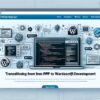Practical Guide to Handling WordPress Media for Improved Load Times

Alright, let’s dive right in and tackle the big bad wolf of web development – load times! Now, I know what you’re thinking – It’s 2021, it’s not as if we’re using dial-up anymore. But trust me when I say that in the world of web development, speed is key, especially when dealing with a content-heavy CMS like WordPress. So grab your cup of coffee (or tea, if you’re fancy like that!), sit back, and let’s banish those sluggish load times into oblivion.
WordPress Media: The Double-Edged Sword
In WordPress, media files can be a blessing and a curse. Now don’t get me wrong, they are essential to making your website visually appealing. But, much like adding too much cheese to your pizza, they can also cause sluggish load times and decrease performance (and in the case of the pizza, your waistline). So, how do we cut down on this load and optimize our sites for peak performance? That’s what we’re here to discuss.
Understand Your Media Usage
Like checking your bank account balance after a weekend splurge, the first step to optimizing your WordPress media is to analyze your current situation. WordPress has a built-in library that shows you all the media files you currently use. From here, you can gauge which files are taking up unnecessary space and slowing down your website. Delete any irrelevant images – it’s like a Spring cleaning, only for your website.
Image Compression: Your Best Friend
Speaking of images, did you know you can compress them without losing quality? Now that’s what I call a game-changer! There are many software applications out there that can easily compress your images to reduce their file size. This way, your website will consume less bandwidth while loading, thus speeding up your load times.
The Magic of Caching
Here’s a joke for all you web developers – Why do programmers always mix up Christmas and Halloween? Because Oct(31) = Dec(25)!
Alright, humor aside, let’s talk caching. Much like that drawer in your home where you toss all your miscellaneous items for “safekeeping”, caching stores previously used data for quicker access in the future. It’s like speed dial, but for your website. WordPress has a plethora of plugins that make caching a breeze.
CDN: The Next Level
Ever dreamt of being in two places at once? Well, with a Content Delivery Network (CDN), your website can make that dream come true! A CDN stores copies of your website on different servers, meaning your site can be accessed quickly, no matter where in the world the user is.
In a nutshell? More speed, fewer problems.
So, there you have it – your beginner’s guide to optimizing WordPress media for improved load times. Remember, a faster website not only improves the user experience but also boosts your Google search ranking. So, dust off that developer’s hat, roll up those sleeves, and start optimizing!
Over and Out
To quote the great web developer Spiderman (okay, maybe not a web developer but he knows a thing or two about webs), “With great power comes great responsibility”. So, wield these optimization powers wisely and go forth, into the exciting world of fast-loading websites!
We’ve covered a lot, but remember – every little bit helps. Good luck and happy coding!


